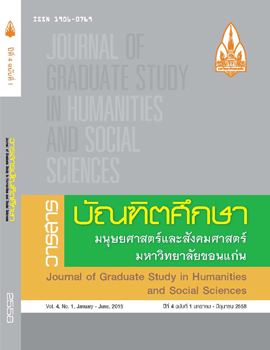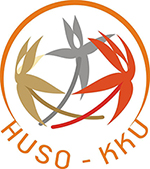Awareness and Behavior on Mobile Phone Hazardous Waste Management: A Case Study among Youth in Bangkok Metropolitan
Keywords:
Mobile Phone HazardousWaste, Awareness, Behavior, ซากของเสียจากโทรศัพท์เคลื่อนที่, ความตระหนัก, พฤติกรรมAbstract
The purposes of this research were to examine the students’ Awareness and Behavior on Mobile Phone Hazardous Waste Management(ABMPWM) comparative studies of dependent variables among the levels of independent variables and their Corresponding correlation’s between their exposure to information and ABMPWM and to yield the appropriate means for managing mobile phone waste. The survey research using self-administered questionnaires was conducted on 450 random samples from 264,027 students with study standing at junior and senior high school in Bangkok. The analytical statistical methods used were percentage, mode, mean, S.D. (Standard Deviation), T-Test, F-Test, One-way ANOVA Analysis, Correlation Analysis and Regression Analysis & Prediction Model.
The level of the Awareness on Mobile Phone Hazardous Waste Management index (AMPHWM index) was high. The AMPHWM index of men was higher than women and significance difference (p<.05). The group of 13-14years of age had AMPHWM index at the highest level. The samples of junior high school students had higher AMPHWMindex than the group of senior high school students. The group of students who bought the mobile phone themselves had higher AMPHWM index than the others. The group of students belonging the mobile phone with 15,000 baht had higher AMPHWM index than the low price. The group of students paying service charge monthly about 301-500 had higher AMPHWM index than the group paying more or less. The group of exposure to information had higher AMPHWM than no exposure to information group. Most of students received information from T.V.. The Awareness on Management of Mobile Phone Waste of the group of exposure to information and the group did not expose to information had correlation to the Behavior on Management of Mobile Phone Waste. The level of the Behavior on Mobile Phone Hazardous Waste Management index (BMPHWM index) was average. The BMPHWM index of men was higher than women. The group of 13-14 years of age had higher than the others. The samples of junior high school students had higher BMPHWM index than the group of senior high school students. The group of students who bought the mobile phone themselves had higher BMPHWM index than the others. The group of students belonging the mobile phone with more 8,001-15,000 baht had higher BMPHWM index than the lower and higher price. The group of students paying service charge monthly about 301-500 had higher BMPHWM than the group paying more or less. The group of exposure to information had higher BMPHWM index than no exposure to information group. The group of students received information from internet or electric media had higher BMPHWM index than the group students who received the information from the others.
There were 3 method and strategy on the mobile phone waste management as follows :
The behavior and operation by the accomplice for suitable management should cover 6 persons and organization groups. They were : (1) The youth using mobile phone. (2) Family or guardian of the youth using mobile phone. (3) The education institutes and communities of the youth living. (4) The stores (selling the mobile phone) (5) The distributors and producer of the mobile phone. (6) The government sectors and private sectors. There were activities to make the concrete effect by creating the suitable measures in activity design for the aims of awareness with public media and awake to protest the wrong practice.We should support the operation to continue study or to expand the boundary which widen the scope by covering electronic waste which should have the multiple mobile phone waste.
ความตระหนักและพฤติกรรมในการจัดการซากของเสียที่เกิดจากโทรศัพท์เคลื่อนที่: กรณีศึกษาเยาวชนในเขตกรุงเทพมหานคร
การศึกษาวิจัยนี้มีวัตถุประสงค์เพื่อศึกษาความตระหนักและพฤติกรรมในการจัดการซากของเสียที่เกิดจากโทรศัพท์เคลื่อนที่ศึกษาเชิงเปรียบเทียบของตัวแปรตามระหว่างระดับต่างๆ กันของตัวแปรอิสระ ศึกษาความสัมพันธ์ระหว่างการรับรู้ข่าวสารกับความตระหนักและพฤติกรรมในการจัดการซากของเสียที่เกิดจากโทรศัพท์เคลื่อนที่ และนำเสนอแนวทางที่เหมาะสมสำหรับการจัดการซากของเสียที่เกิดจากโทรศัพท์เคลื่อนที่ เป็นการศึกษาวิจัยเชิงการสำรวจจากกลุ่มประชากรที่กำลังศึกษาในระดับมัธยมศึกษาตอนต้นและมัธยมศึกษาตอนปลายของโรงเรียนในสังกัดสำนักงานการศึกษาขั้นพื้นฐาน (สพฐ.) กระทรวงศึกษาธิการในเขตกรุงเทพมหานคร จำนวนทั้งสิ้น 264,027 คน สุ่มมาเป็นกลุ่มตัวอย่างได้ 450 คน เครื่องมือที่ใช้ ใช้แบบสอบถามในการเก็บข้อมูลปฐมภูมิ และนำมาประมวลผลด้วยคอมพิวเตอร์โดยการใช้โปรแกรมคำสั่งสำเร็จรูปใช้การวิเคราะห์ด้วยวิธีการทางสถิติได้แก่ ค่าแจกแจงความถี่ค่าร้อยละ ค่าเฉลี่ย และค่าส่วนเบี่ยงเบนมาตรฐาน วิเคราะห์เปรียบเทียบตัวแปรด้วยสถิติ ค่า T-test และ F– test วิเคราะห์ความแปรปรวนทางเดียว (One-way ANOVA Analysis) วิเคราะห์ค่าสหสัมพันธ์ของตัวแปรด้วยสถิติ Correlation Analysis และสมการพยากรณ์ถดถอย (Regression Analysis & Prediction Model)
ผลการวิเคราะห์เชิงสถิติกลุ่มตัวอย่างได้ดัชนี “ความตระหนักในการจัดการซากของเสียที่เกิดจากโทรศัพท์เคลื่อนที่” อยู่ในระดับสูง เพศชายได้ดัชนี “ความตระหนักในการจัดการซากของเสีย” สูงกว่าเพศหญิงและมีความแตกต่างกันอย่างมีนัยสำคัญทางสถิติที่ระดับ 0.05 กลุ่มอายุ 13-14 ปี ได้ดัชนี “ความตระหนักในการจัดการซากของเสีย” สูงที่สุด กลุ่มที่ศึกษาอยู่ระดับมัธยมศึกษาตอนต้นได้ดัชนี “ความตระหนักในการจัดการซากของเสีย” สูงกว่าระดับมัธยมศึกษาตอนปลาย กลุ่มที่ซื้อโทรศัพท์เคลื่อนที่ด้วยเงินของตนเองได้ดัชนี “ความตระหนักในการจัดการซากของเสีย” สูงกว่ากลุ่มที่ได้มาด้วยวิธีการอื่น ๆ กลุ่มที่ซื้อโทรศัพท์เคลื่อนที่ในราคา 15,000 บาทขึ้นไป ได้ดัชนี “ความตระหนักในการจัดการซากของเสีย” สูงกว่ากลุ่มที่ซื้อในราคาต่ำกว่า กลุ่มที่มีค่าบริการในการใช้โทรศัพท์เคลื่อนที่เฉลี่ยต่อเดือน 301-500 บาทได้ดัชนี “ความตระหนักในการจัดการซากของเสีย” สูงกว่ากลุ่มที่มีค่าบริการในการใช้โทรศัพท์เคลื่อนที่เฉลี่ยต่อเดือนสูงกว่าและต่ำกว่า กลุ่มที่ได้รับรู้ข่าวสารได้ดัชนี “ความตระหนักในการจัดการซากของเสีย” สูงกว่ากลุ่มที่ไม่ได้รับรู้ข่าวสาร กลุ่มที่ได้รับรู้ข่าวสารจากโทรทัศน์ได้ดัชนี “ความตระหนักในการจัดการซากของเสีย” สูงกว่ากลุ่มที่ได้รับรู้จากแหล่งอื่น ๆ ดัชนี “ความตระหนักในการจัดการซากของเสีย” ของกลุ่มที่รับรู้ข่าวสารและไม่ได้รับรู้ข่าวสารมีความสัมพันธ์กับดัชนี “พฤติกรรมการจัดการซากของเสีย” มีค่าสหสัมพันธ์ r = 0.395 ค่าดัชนี “พฤติกรรมการจัดการซากของเสียที่เกิดจากโทรศัพท์เคลื่อนที่” อยู่ในระดับปานกลางเพศชายได้ดัชนี “พฤติกรรมการจัดการซากของเสีย” ที่สูงกว่าเพศหญิง กลุ่มอายุ 13-14 ปี ได้ดัชนี “พฤติกรรมการจัดการซากของเสีย” สูงกว่ากลุ่มอายุอื่นๆกลุ่มมัธยมศึกษาตอนต้นได้ดัชนี “พฤติกรรมการจัดการซากของเสีย”สูงกว่าระดับมัธยมศึกษาตอนปลาย กลุ่มที่ซื้อโทรศัพท์เคลื่อนที่ด้วยเงินของตนเองได้ดัชนี “พฤติกรรมการจัดการซากของเสีย” สูงกว่ากลุ่มที่ได้โทรศัพท์เคลื่อนที่มาด้วยวิธีการอื่น ๆ กลุ่มที่ซื้อโทรศัพท์เคลื่อนที่ในราคา15,000 บาทขึ้นไปได้ดัชนี“พฤติกรรมการใช้โทรศัพท์เคลื่อนที่” สูงกว่ากลุ่มที่ซื้อในราคาสูงกว่าและต่ำกว่า กลุ่มที่มีค่าบริการเฉลี่ยต่อเดือน 301-500 บาท ได้ดัชนี “พฤติกรรมการจัดการซากของเสีย” สูงกว่ากลุ่มที่มีค่าบริการต่อเดือนสูงกว่าและต่ำกว่า กลุ่มที่ได้รับรู้ข่าวสารเกี่ยวกับซากและการจัดการซากของเสียที่เกิดจากโทรศัพท์เคลื่อนที่ได้ดัชนี“พฤติกรรมการจัดการซากของเสีย” สูงกว่ากลุ่มที่ไม่ได้รับรู้ข่าวสารกลุ่มที่ได้รับรู้ข่าวสารจากอินเตอร์เน็ต/สื่ออิเล็กทรอนิกส์ได้ดัชนี“พฤติกรรมการจัดการซากของเสีย” สูงกว่ากลุ่มที่ได้รับรู้ข่าวสารจากแหล่งอื่น ๆ แนวทางและกลยุทธ์ในการจัดการซากของเสียที่เกิดจากโทรศัพท์เคลื่อนที่ ใน 3 ประการ ดังนี้ ประการแรกการปฏิบัติตนและการดำเนินการโดยผู้เกี่ยวข้องเพื่อการบริหารจัดการที่เหมาะสม ควรจะให้ครอบคลุมถึงบุคคลและองค์กร 6 กลุ่ม ได้แก่ (1) เยาวชนผู้ใช้โทรศัพท์เคลื่อนที่ (2) ครอบครัว หรือผู้ปกครองของเยาวชนผู้ใช้โทรศัพท์เคลื่อนที่ (3) สถานศึกษาและชุมชนที่เยาวชนสังกัดอยู่ (4) ร้านค้า (ผู้จำหน่ายโทรศัพท์เคลื่อนที่) (5) ตัวแทนจำหน่ายและผู้ผลิตโทรศัพท์เคลื่อนที่ (6) องค์กรภาครัฐและองค์กรภาคเอกชน ประการที่สองการจัดให้มีกิจกรรมเพื่อการกระตุ้นให้เกิดผลที่เป็นรูปธรรมด้วยการวางมาตรการที่เหมาะสมในการออกแบบกิจกรรม ทั้งนี้ เพื่อมุ่งหวังให้เกิดความตระหนักด้วยสื่อสาธารณะ และการปลุกให้เกิดกระแสการต่อต้านของการปฏิบัติที่ไม่ถูกต้อง ประการที่สามการสนับสนุนให้มีการดำเนินการเพื่อการศึกษาต่อเนื่องหรือการขยายขอบเขตที่ต่อยอดให้ในขอบข่ายที่กว้างขวางยิ่งขึ้น โดยให้ครอบคลุมถึงการจัดการขยะอิเล็กทรอนิกส์ด้วย ซึ่งน่าจะมี ปริมาณมากกว่าซากโทรศัพท์เคลื่อนที่อีกหลายเท่าตัว







